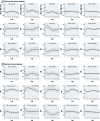The temporal lag structure of short-term associations of fine particulate matter chemical constituents and cardiovascular and respiratory hospitalizations
- PMID: 22609899
- PMCID: PMC3440088
- DOI: 10.1289/ehp.1104721
The temporal lag structure of short-term associations of fine particulate matter chemical constituents and cardiovascular and respiratory hospitalizations
Abstract
Background: In air pollution time-series studies, the temporal pattern of the association of fine particulate matter (PM2.5; particulate matter ≤ 2.5 µm in aerodynamic diameter) and health end points has been observed to vary by disease category. The lag pattern of PM2.5 chemical constituents has not been well investigated, largely because daily data have not been available.
Objectives: We explored the lag structure for hospital admissions using daily PM2.5 chemical constituent data for 5 years in the Denver Aerosol Sources and Health (DASH) study.
Methods: We measured PM2.5 constituents, including elemental carbon, organic carbon, sulfate, and nitrate, at a central residential site from 2003 through 2007 and linked these daily pollution data to daily hospital admission counts in the five-county Denver metropolitan area. Total hospital admissions and subcategories of respiratory and cardiovascular admissions were examined. We assessed the lag structure of relative risks (RRs) of hospital admissions for PM2.5 and four constituents on the same day and from 1 to 14 previous days from a constrained distributed lag model; we adjusted for temperature, humidity, longer-term temporal trends, and day of week using a generalized additive model.
Results: RRs were generally larger at shorter lags for total cardiovascular admissions but at longer lags for total respiratory admissions. The delayed lag pattern was particularly prominent for asthma. Elemental and organic carbon generally showed more immediate patterns, whereas sulfate and nitrate showed delayed patterns.
Conclusion: In general, PM2.5 chemical constituents were found to have more immediate estimated effects on cardiovascular diseases and more delayed estimated effects on respiratory diseases, depending somewhat on the constituent.
Conflict of interest statement
The views expressed are those of the authors and do not necessarily reflect the views or policies of the U.S. Environmental Protection Agency.
The authors declare they have no actual or potential competing financial interests.
Figures



Comment in
-
What a difference a day makes: examining the lag patterns of PM2.5 constituents.Environ Health Perspect. 2012 Aug;120(8):a321. doi: 10.1289/ehp.120-a321b. Environ Health Perspect. 2012. PMID: 22853926 Free PMC article. No abstract available.
References
-
- Brook RD, Rajagopalan S, Pope CA, III, Brook JR, Bhatnagar A, Diez-Roux AV, et al. Particulate matter air pollution and cardiovascular disease: an update to the scientific statement from the American Heart Association. Circulation. 2010;121:2331–2378. - PubMed
-
- Colorado Hospital Association. Discharge Data Program. 2012. Available: http://www.cha.com/CHA/Resources/Discharge_Data/CHA/_Member_Services/_da... [accessed 29 June 2012]
Publication types
MeSH terms
Substances
Grants and funding
LinkOut - more resources
Full Text Sources

